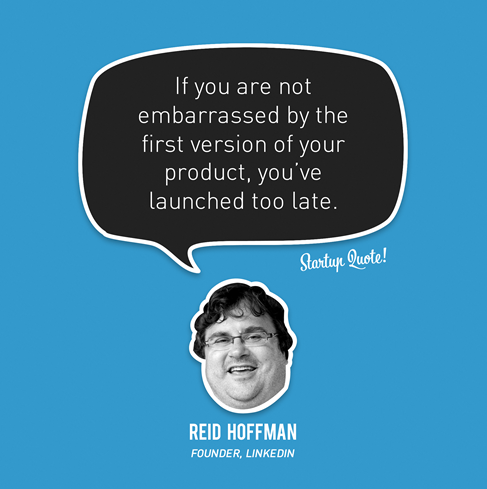
So you want to bootstrap your product business. Where to start? There is so much great content online. But lack of information is never the issue.
Things often go wrong because:
1. People don’t act upon information. They passively consume, but they don’t act. “It’s not yet the perfect moment”, “I can do this later”, “In 10 years from now I will do ABC”, “I will first read those 241 business books”.
2. People act, but they do not know what to focus on or focus on the wrong things. There is so much information. Where do you start? What is the next single thing to focus on? What makes sense, for you, right now, to do next? By focussing on the right things first, you can win months of time, save ten thousands of dollars, and sleep much more.
The first point I can’t solve for you. Just realize that nobody pays you for genius ideas if you don’t act upon them. Actions speak louder than words. A good plan violently executed now is better than a perfect plan executed next week. Like people who say for years they will stop smoking, but never do it. If you still need someone else to tell the same, read this “JUST DO IT” article.
The second point is something that I might help with. Why? Because in the past, I have done things in the wrong order. Developing an application (for months!) before calling potential customers is a very bad idea. Translating your app into 10 languages is not the smartest thing to do if you don’t have paying customers yet.
I lost months of time and thousands of dollars. You don’t have to! Read on, my friend…
If you do things in the right order, you reduce the bootstrapping risk a lot. Start with the most risk full and difficult parts, and nail them. If you can fix the most difficult parts, then the rest is peanuts, no? Then move on to the next – more easy and less risky – thing. Hiring a logo designer and printing business cards is not difficult at all. Don’t do it first!
By doing things in the right order, focussing on one thing at a time, over less than a year I bootstrapped a product from nothing to $3K MRR. That’s not a million dollar business, but I’m quite happy with it. I know we can scale, and we actually do grow every day. How and why? Because the focus has been always on the right thing – one thing at a time.
Below the order of things to focus on, one by one, from day 1 until you have your first paying customer(s). This covers a couple of months (between 3 and 6 I would say). The very first paying customer is the hardest to get. Once you learned how to get 1 customer, you can get a second customer, you can get 10, and eventually 100 or 1000 of customers. (Note: I’m now getting into the 100erds range.)
From this list, handle one topic at a time. You can keep an eye on what’s next, but not more than that. FOCUS step by step on the right thing. The most risk full and difficult things first, so you don’t spend time, energy, money and frustration into easy things.
Here you go…
PHASE #1 – FINDING THE PAIN & TESTING IF YOU CAN SELL THE SOLUTION
Step 1.1 – Get the mindset of “product people”, “bootstrappers” and “scalable thinking”. Read some of the books I recommend. I’d suggest to read them all over a couple of years, but don’t wait acting! Go to step 1.2 while you read the first book. Just reading books won’t help you any further!
Step 1.2 – Find a PAIN for a NICHE. This is the most “risky” part. If you don’t nail this, every further step becomes more difficult or even impossible. The bigger the pain you solve, the more easy to find customers, have them paying, have the word spreading, … Calling niches is the single best way to achieve this.
Step 1.3 – Check and test if you can actually reach your audience / sell your solution / market your product (without having built it!). Can you set up a website and drive traffic to it & have people sign up? Use whatever technique: Google ads, calling, blogging, leave replies on forums, send out emails, … If you can’t reach your audience now, you won’t be able to do it later. You should be able to get a few 100 people (email addresses) on your list.
PHASE #2 – BUILDING THE MVP AND GETTING YOU FIRST PAYING CUSTOMER(S).
Step 2.1 – Build the very minimal solution / product & ship it (or ask someone to build it), even if it is not shiny, has bugs, and does not contain all the features you think are necessary. Focus on the core functionality only. Don’t spend too much attention on the name and the logo. Weeks of brainstorming about them is a common pitfall. Please, don’t even think on printing business cards.
Step 2.2 – Build GREAT (no average) content that interests your audience / niche. Post this on a blog so google starts loving you. Don’t spend too much time on the look and feel, just make sure the actual content is great. Also send this content to your pre-subscribers to keep them warm. If you do this good, you build a lot of trust with your audience, and you start getting traffic through Google searches. This content is a goldmine: it can be reused later for drip campaigns, making a free ebook for your audience (in exchange for email address), guest posts, comments on forums, and so on. It can be used to scale and automated your marketing. It deserves the same investment and energy as the actual product, coding and software!
Step 2.3 – Once you have the MVP and you did send some content to build trust, send out a launch email to a first small batch of people that signed up. You should see some conversions and your first paying customer should be a fact! The first few paying customers are the hardest to get. You have done a lot of work upfront, but once you have that first payment notification in your mailbox, it finally starts to pay off.
Champagne (or coffee or beer)!
There is much more in product business. A/B testing, SEO, paid advertising, conversion optimizing, automating your marketing, good support, scaling, drip campaigns, blogging, and so on. Those topics will be covered later on this blog in future articles. But as long as you don’t have your first paying customer, don’t worry about all of this. Focus on achieving that first paying customer.
Hey, pssst…btw. Do me a favour and tweet and share this blogpost if you like it. It encourages me to write more :-)
Ah, and if you like this article, don’t forget to subscribe to the RSS feed or add yourself to my mailing list for more exclusive content.

